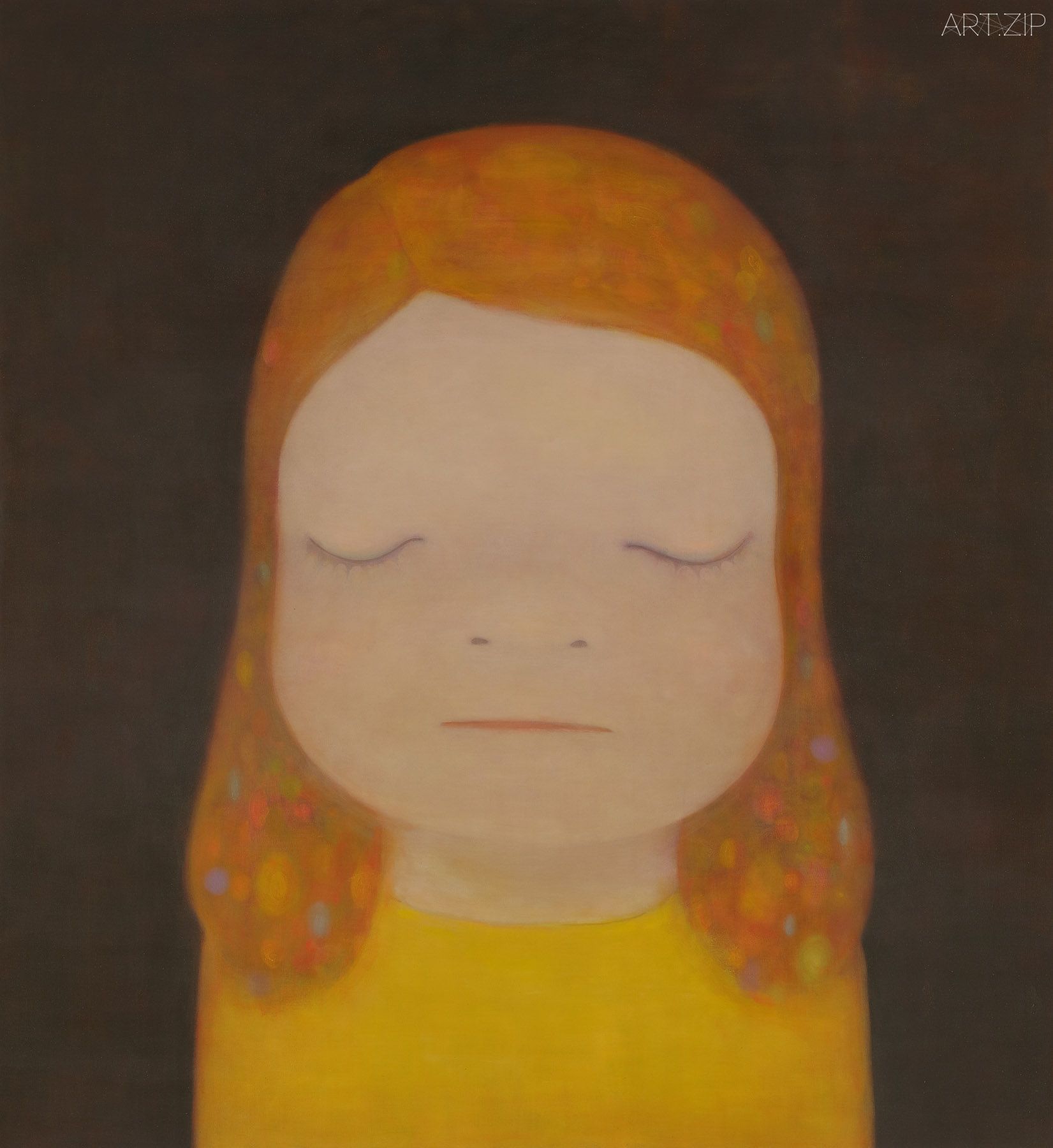
Yoshitomo Nara
10 Jun – 31 Aug 2025
Hayward Gallery, London
Yoshitomo Nara’s children do not smile. They glare, pout, sulk – or stare straight back at you with unsettling clarity. These wide-eyed, child-like figures, so central to Nara’s practice, have long evoked a range of contradictory responses: tenderness, defiance, vulnerability, and strength. They might seem familiar, yet remain curiously unknowable – unresolved fragments of a psyche that resists simplification.
Currently on view at Hayward Gallery in London, Yoshitomo Nara marks the artist’s first UK solo exhibition and his most comprehensive retrospective in the country to date. Spanning over 150 works – from paintings and drawings to sculpture – the exhibition traces a 40-year career that defies easy categorisation. It unfolds not through dramatic transformation but through subtle shifts in tone, medium, and emotional register over many years.
Nara has often rejected the notion that his iconic characters are self-portraits, especially in this press preview. Instead, he refers to them as his “Bunshin” – a Japanese term (分身) meaning spiritual double or alter ego. These are not literal representations of self, but projections of his inner world, at once personal and collective. This tension – between self and other, isolation and communication – runs through his practice like a steady pulse.
At the exhibition’s press preview, Nara stood before us in a classic sukajan jacket and baseball cap, modest and soft-spoken, yet his presence filled the room with a quiet intensity. Music is central to Nara’s identity. He often says that when he is in the world of music, he feels most like himself. Near the entrance, a wall adorned with vinyl records from his personal collection—punk, rock, folk—offers a glimpse into the sonic landscape that has shaped him since his youth. These genres not only influence his aesthetic but pulse through the exhibition like an underlying rhythm. Rock and roll, undeniably, beats at the heart of Nara’s creative soul.
One of the most compelling aspects of this exhibition is the slow, organic evolution it reveals. Early works featuring defiant, almost confrontational girls gradually give way to softer, more introspective figures. The emotional charge remains, but it is modulated – less about shouting, more about listening.
During the preview, I had the opportunity to pose a question to the artist: “If life is a long process of gestation, what stage do you think you’re in now? Are there works you’ve been quietly waiting to bring into the world? (人生が長い『孕み』の過程だとしたら、今ご自身はどの段階にいると感じますか?これまでずっと生まれるのを待っているような作品はありますか?)”
Nara replied: “I honestly never think like that when I’m creating. I don’t consciously plan my works. But once something is finished and I look back, I start to discover all sorts of reasons why I might have created it. That process—of finding meaning in my own work after it’s done—is something I really enjoy. So I’ve always thought I’m on the very last step. Then I look behind me, there’s a long staircase. Then I think, right I’ve got some more to come. (僕は本当に考えていないですよ、物作り時に。でも、考えてきた物をそのまま出しただけ。できた瞬間に、どうして自分がこれを作ったんだろうと思うとすごい理由がたくさん見つかってくる。その自分で自分が作ったものを見て理由を探すのがすごく楽しいです。いつも最後の階段だと思うんですけど、そこから、過去を一回見て、もう一回振り返ると、更に階段を見える。)”
This response reveals a defining quality of Nara’s oeuvre: its refusal to be pinned down by intention. Creation becomes a form of subconscious expression, and meaning–like memory–is constructed retrospectively. His works emerge intuitively, but their emotional clarity sharpens in hindsight – both for the artist and for the viewer.
Underlying much of Nara’s practice is a persistent pacifism. Born in post-war Japan and deeply affected by the 2011 Great East Japan Earthquake, Nara has long positioned his art as a quiet protest against violence, nuclear power, and historical amnesia. But rather than didactic or overtly political, his protest is distilled into emotion, atmosphere, and affect. His characters are not messengers of ideology but emblems of endurance.
Under the Hazy Sky (2012) was created by Yoshitomo Nara in the wake of the 2011 Fukushima nuclear disaster. Following the devastating earthquake and tsunami that struck Japan, the Fukushima Daiichi Nuclear Power Plant was severely damaged, leading to widespread radioactive contamination in the surrounding region. Deeply moved by the tragedy, Nara responded not only through his art but also by organising creative workshops for children displaced by the disaster, offering them moments of comfort and expression amid the turmoil.
Nara’s sculptures are rich with spirituality and humanity. In sculpture works like Miss Forest (2010), and Miss Forest, a Pedestal (2023), the emotional and spiritual dimension become even more pronounced. The figures resonate with the Shinto traditions of Nara’s childhood, evoking protective Jizō statues and nature deities known as Kami. These sculptures often are placed in natural setting across the globe, act as sentinels – guardians of memory, witness to ecological fragility, and symbols of care.
What sets Nara apart from his imitators – many of whom mimic his visual language without capturing its emotional resonance – is the lived experience embedded in every line and colour. His art is haunted by time: by what has passed, what remains unresolved, and what quietly waits to be born and becoming.
At its heart, Nara’s art calls for empathy – not sentimentality, but a raw, unflinching connection between artist and viewer. In a world increasingly mediated by surface and spectacle, such vulnerability is nothing short of radical.
奈良美智筆下的「孩子」從不微笑。他們怒目而視、噘嘴、悶悶不樂——又或以清澈得近乎不安的眼神,直勾勾地回望觀者。這些大眼睛、類似孩童的形象是奈良創作的核心,長久以來激發著矛盾的情感:溫柔與反叛、脆弱與堅韌。他們似曾相識,卻又難以言說,彷彿是那些不願被簡化的精神碎片。
倫敦海沃德畫廊目前正在舉辦奈良美智在英國的首次大型個展,也是迄今為止最全面的回顧展。展覽上展出超過150件作品,涵蓋繪畫、素描與雕塑,呈現其橫跨四十年的創作生涯。這段旅程無關劇烈的轉折,而是透過語調、媒材與情感層次的微妙變化,緩緩推進。
儘管外界常將那些標誌性的角色誤認為藝術家的自畫像,奈良卻多次予以否認,尤其在此次媒體預展上。他稱它們為自己的「分身(Bunshin)」——日文中意指靈魂的複製、替身。這些角色並非自我的直接呈現,而是他內在世界的投射——既個人又集體。在自我與他者、孤獨與交流之間的緊張關係貫穿了他整體的創作脈絡,如同穩定而深沉的脈搏。
在媒體預展現場,奈良身著經典的日式橫須賀外套與棒球帽,謙遜而安靜,卻有一種低頻而有力的氣場填滿整個空間。音樂是他自我認同的核心。他曾說,唯有在音樂中,他才能真正感覺像自己。展覽入口處的一整面牆上陳列著自少年以來就影響著他的黑膠唱片收藏——龐克、搖滾、民謠——這些音樂不僅塑造了他的美學風格,也如隱約潛伏的節奏貫穿整場展覽。在奈良心中,搖滾精神從未熄滅。
這場展覽最動人的部分在於它所揭示的那段細微且自然的演變:從早期那些充滿挑釁眼神的少女角色,到近期更加溫柔與內省的面孔,那些情感的張力從未消失,不再高聲呼喊,而是轉向靜靜傾聽。
預展當天我們有幸向奈良提問:「如果人生是一段漫長的孕育過程,您覺得自己現在正處於哪個階段?是否有某些作品是您一直在等待它誕生的?」
他答道:「其實我創作的時候從沒這樣想過。我不會事先計劃作品。但當作品完成、回頭去看時,就會慢慢發現為甚麼創作了這樣的作品,理由也會一個個浮現。對我來說,去尋找作品背後的理由是件很有趣的事。我總以為自己已經走到了最後一階。然後回頭一看,才發現身後是一段長長的階梯。於是我想,嗯,我好像還可以再繼續往前走一點。」
這段回應點出了奈良創作的核心:拒絕被明確意圖所框定。他的作品更接近潛意識的流露,而意義,如同記憶,是在事後被建構而成的。他的作品往往誕生於直覺,卻在回望中逐漸顯現情感的輪廓——對他而言如此,對觀者亦然。
奈良的創作深處潛藏著一股持續不息的和平主義。他生於二戰後的日本,也深受2011年東日本大地震的衝擊。長久以來,他將自己的藝術視為對暴力、核能與歷史遺忘的無聲抗議。這份抗議並不激烈,也不政治化,而是凝鍊為氛圍、感知與情緒。他筆下的角色不是理念的傳聲筒,而是堅韌精神的象徵。
《朦朧天空之下》(2012)是奈良美智在2011年福島核災之後創作的作品。當年強震與海嘯重創日本,導致福島第一核電廠嚴重受損,引發周邊地區大規模的放射性污染。奈良美智深受事件觸動,不僅以創作回應,也為受災而流離失所的孩童舉辦藝術工作坊,在混亂中為他們提供一個能表達、能療癒的空間。
值得一提的是奈良的雕塑作品,靜謐且充滿靈性。在《森林之子》(2010)與《森林之子,台座版》(2023)等作品中,那份精神性更為強烈,令人聯想到他童年記憶中的神道教傳統,如守護孩童的地藏尊者,以及自然神祇「神(Kami)」。奈良將這些雕塑分散安置於全球各地的自然場域中,讓它們成為見證者:見證生態的脆弱,也象徵溫柔的守護。
那些奈良風格模仿者往往只是複製了奈良的視覺語彙,卻觸及不到作品內裏的情感重量。奈良作品裡的每一筆線條與色彩都承載著他親身經歷的時光,記錄著過去的流逝,回響著未解的情緒,也靜靜孕育著尚未抵達的未來。
歸根究柢,奈良的藝術喚起的是一種深刻的同理——不是膚淺的感傷,而是一種不閃躲、不修飾的情感連結。在這個充斥著喧囂與表象的時代,這樣的脆弱與真誠,無疑是一種深刻且激進的表達。

Yoshitomo Nara, Fountain of Life, 2001. © Yoshitomo Nara, courtesy Yoshitomo Nara Foundation.
Text by Rinka Fan
Edited by Michelle Yu

































